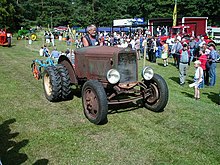
A tractor is an engineering vehicle specifically designed to deliver a high tractive effort at slow speeds, for the purposes of hauling a trailer or machinery such as that used in agriculture, mining or construction. Most commonly, the term is used to describe a farm vehicle that provides the power and traction to mechanize agricultural tasks, especially tillage, and now many more. Agricultural implements may be towed behind or mounted on the tractor, and the tractor may also provide a source of power if the implement is mechanised.

The Ford Model T is an automobile that was produced by the Ford Motor Company from October 1, 1908, to May 26, 1927. It is generally regarded as the first mass-affordable automobile, which made car travel available to middle-class Americans. The relatively low price was partly the result of Ford's efficient fabrication, including assembly line production instead of individual handcrafting. The savings from mass production allowed the price to decline from $780 in 1910 to $290 in 1924. It was mainly designed by three engineers, Joseph A. Galamb, Eugene Farkas, and Childe Harold Wills. The Model T was colloquially known as the "Tin Lizzie".
The White Motor Company was an American automobile, truck, bus and agricultural tractor manufacturer from 1900 until 1980. The company also produced bicycles, roller skates, automatic lathes, and sewing machines. Before World War II, the company was based in Cleveland, Ohio. White Diesel Engine Division in Springfield, Ohio, manufactured diesel engine generators, which powered U.S. military equipment and infrastructure, namely Army Nike and Air Force Bomarc launch complexes, and other guided missile installations and proving grounds, sections of SAGE and DEW Line stations, radars, Combat Direction Centers and other ground facilities of the U.S. aerospace defense ring, such as the Texas Towers.
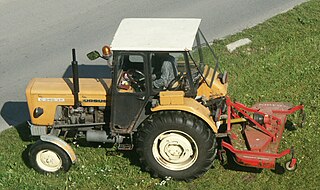
The three-point hitch is a widely used type of hitch for attaching ploughs and other implements to an agricultural or industrial tractor. The three points resemble either a triangle, or the letter A. In engineering terms, three-point attachment is the simplest and the only statically determinate way of rigidly joining two bodies.

The International Harvester Company was an American manufacturer of agricultural and construction equipment, automobiles, commercial trucks, lawn and garden products, household equipment, and more. It was formed from the 1902 merger of McCormick Harvesting Machine Company and Deering Harvester Company and three smaller manufacturers: Milwaukee; Plano; and Warder, Bushnell, and Glessner. Its brands included McCormick, Deering, and later McCormick-Deering, as well as International. Along with the Farmall and Cub Cadet tractors, International was also known for the Scout and Travelall vehicle nameplates. In the 1980s all divisions were sold off except for International Trucks, which changed its parent company name to Navistar International.

Fordson was a brand name of tractors and trucks. It was used on a range of mass-produced general-purpose tractors manufactured by Henry Ford & Son Inc from 1917 to 1920, by Ford Motor Company (U.S.) and Ford Motor Company Ltd (U.K.) from 1920 to 1928, and by Ford Motor Company Ltd (U.K.) alone from 1929 to 1964. The latter also later built trucks and vans under the Fordson brand.
Doodlebug or doodle bug may refer to:

The Ford flathead V8 is a V8 engine with a flat cylinder head introduced by the Ford Motor Company in 1932 and built by Ford through 1953. During the engine's first decade of production, when overhead-valve engines were used by only a small minority of makes, it was usually known simply as the Ford V‑8, and the first car model in which it was installed, the Model 18, was often called simply the "Ford V-8" after its new engine. An automotive milestone as the first affordable V8, it ranks as one of the company's most important developments. The engine was intended to be used for big passenger cars and trucks; it was installed in such until 1953, making the engine's 21-year production run for the U.S. consumer market longer than the 19-year run of the Ford Model T engine. It was also built independently by Ford licensees.. The engine was named on Ward's list of the 10 best engines of the 20th century. It was a staple of hot rodders in the 1950s, and it remains famous in the classic car hobbies even today, despite the huge variety of other popular V8s that followed.

Sieper Lüdenscheid GmbH & Co. KG, mostly known by its trade name Siku, is a German manufacturer of scale models headquartered in Lüdenscheid. Some of the products sold by Siku are model cars, figurines, model aircraft, model commercial vehicles, and model agricultural machinery. Traditionally, production was centered in Lüdenscheid, but diecast models are now made in China, the Philippines, Taiwan and Vietnam.

Truck and tractor pulling, also known as power pulling, is a form of a motorsport competition in which antique or modified tractors pull a heavy drag or sled along an 11-meter-wide (35 ft), 100-meter-long (330 ft) track, with the winner being the tractor that pulls the drag the farthest. Tractor pulling is popular in certain areas of the United States, Mexico, Canada, Europe, Australia, Brazil, South Africa, Vietnam, India and New Zealand. The sport is known as the world's most powerful motorsport, due to the multi-engined modified tractor pullers.

The Ford N-series tractors were a line of farm tractors produced by Ford between 1939 and 1952, spanning the 9N, 2N, and 8N models.
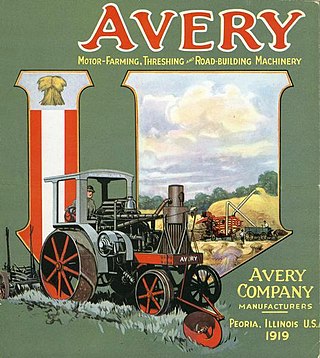
The Avery Company, founded by Robert Hanneman Avery, was an American farm tractor manufacturer famed for its undermounted engine which resembled a railroad engine more than a conventional farm steam engine. Avery founded the farm implement business after the Civil War. His company built a large line of products, including steam engines, beginning in 1891. The company started with a return flue design and later adapted the undermount style, including a bulldog design on the smokebox door. Their design was well received by farmers in central Illinois. They expanded their market nationwide and overseas until the 1920s, when they failed to innovate and the company faltered. They manufactured trucks for a period of time, and then automobiles. until they finally succumbed to an agricultural crisis and the Depression.

The Diamond T Company was an American automobile and truck manufacturer. They produced commercial and military trucks.
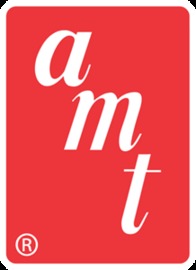
Aluminum Model Toys (AMT) is an American brand of scale model vehicles. The former manufacturing company was founded in Troy, Michigan, in 1948 by West Gallogly Sr. AMT became known for producing 1:25 scale plastic automobile dealer promotional model cars and friction motor models, and pioneered the annual 3-in-1 model kit buildable in stock, custom, or hot-rod versions. The company made a two-way deal in 1966 with Desilu Productions to produce a line of Star Trek models and to produce a 3/4 scale exterior and interior filming set of the Galileo shuttlecraft. It was also known for producing model trucks and movie and TV vehicles.
In the United States, with regard to automobiles, a glider is a vehicle without a powertrain. Gliders are generally sold as unused car bodies, but a second-hand car may also be stripped of its powertrain and sold as a glider. The purpose of such a vehicle is to be used as a base for a non-standard powertrain, to create a novel variation of a conventional vehicle, custom car, exotic vehicle, or homemade electric vehicle conversion. The term is analogous to an aircraft with no engine being a glider.
The Hubley Manufacturing Company was an American producer of a wide range of cast-iron toys, doorstops, and bookends. Toys, particularly motor vehicles and cap guns, were also produced in zinc alloy and plastic. The company is probably most well known for its detailed scale metal kits of Classic cars in about 1:20 scale. Starting in 1960, Hubley participated for a couple of years with Detroit automakers as a plastic promotional model maker. Many Hubley toys are now sought-after collectibles.
The Gere Sport was an American single-seat sport biplane of the 1930s. Designed for amateur construction by George E. Gere, Jr. while a young student at the University of Minnesota. It was later used as the basis of the 1960s EAA Biplane.

Belarus had third by volume part of automotive industry of the Soviet Union with near 40,000 annual production. Since that times Belarus specializes on production of own designed superheavy, heavy and middle trucks mainly plus post-Soviet developed buses, trolleybuses and trams. Auto manufacturers in Belarus include MAZ, BelAZ and Neman.

The GAZ-A is a passenger car that was mass-produced by GAZ from 1932 until 1936. It was the first passenger car to be produced in the Soviet Union and is a near-exact copy of the Ford Model A from 1930. To the local population, the car was nicknamed "Gazik".
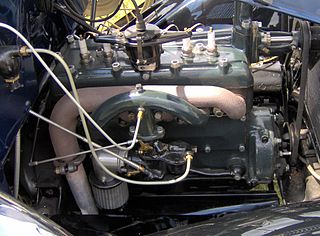
The Ford Model A engine – primarily developed for the popular Ford Model A automobile – was one of the most mass-produced automobile engines of the 1920s and 1930s, widely used in automobiles, trucks, tractors, and a wide variety of other vehicles and machinery.
